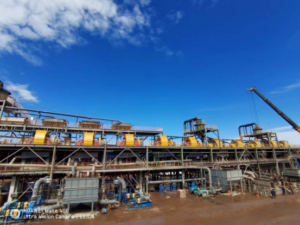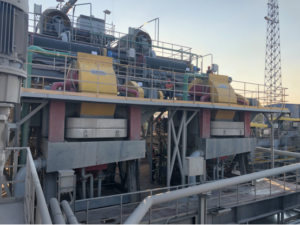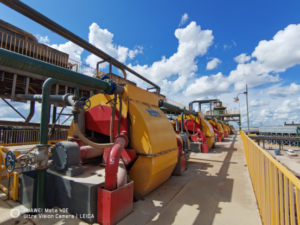Mineral Introduction
Copper is one kind of non-ferrous metals closely related to human beings. It is not only rich in natural resources, but also has electrical conductivity, thermal conductivity, ductility, corrosion resistance, wear resistance and other excellent properties, which is widely used in electric power, electronics, energy and petrochemical, machinery and metallurgy, transportation, light industry, emerging industries and other fields. Cobalt is a kind of silver grey metals, which has good high temperature resistance, corrosion resistance and magnetic properties. It is widely used in aerospace, machinery manufacturing, electrical and electronics, chemical, ceramics and other industrial areas. As one of the important raw materials to make high temperature alloy, hard alloy, ceramic pigment, catalyst and battery, it plays an active role in the future of new energy strategy.
Copper-cobalt ore is the important sources of pure metal copper and cobalt, which is the associated mineral of cobalt ore and copper ore. It’s found that there are many world-famous sedimentary copper-cobalt deposits in the Central African copper belt of Congo (DRC) and Zambia, among which the Congo (DRC) copper-cobalt deposit is a sand-shale stratabound deposit. It is estimated that the copper deposits in Congo and Zambia contain more than 150 million tons of copper and over 8 million tons of cobalt, most of which are located in DRC.
Taking the copper-cobalt mine in Kinkluvezi of Congo as an example, the occurrence state of copper and cobalt is mainly as follows.
(1) The occurrences of copper
There are many kinds of copper minerals and copper-bearing minerals, of which copper sulfide is mainly chalcocite, and a little bit of bornite and chalcopyrite. The copper oxide ore is mainly malachite, and also contains a small amount of pseudo- malachite, silicon malachite and shattuckite. Due to the poor floatability of silicon malachite and shattuckite, the recovery of copper oxide ore will be affected to a certain extent.
(2) The occurrences of cobalt
Cobalt is scattered in various minerals. Carrollite, cobalt psilomelane and cobalt shattuckite are rich cobalt minerals, but the reserves are lack. Most of the cobalt dispersion mainly exists in heterogenite, trieuite, psilomelane containing copper and cobalt, sulphurous copper-cobalt ore, shattuckite, malachite, pseudo-malachite, chrysocolla, cobalt dolomite, calcite, siltstone and etc. Therefore, the recovery rate of cobalt oxide concentrates will be relatively low.
The diversity of copper and cobalt occurrences in copper-cobalt ore inevitably leads to the complexity of beneficiation process, and a single process or chemical reagent cannot achieve the ideal recovery effect. The combination of various beneficiation processes and reagents is the necessary choice to collect copper-cobalt ore.
Flotation and Magnetic Separation applied in Copper-cobalt Ores
Beneficiation technology of copper-cobalt ore: Up to now, flotation is still the main method to enrich copper and cobalt. The main treatment method of cobalt sulfide ores at home and abroad is to separate cobalt and other metal sulfides by flotation technology first. As for whether to float or depress cobalt ores, it depends on the difference of floatability of cobalt-bearing minerals, other valuable metal minerals and gangue minerals. For example, there are usually two technical routes for the copper-cobalt ore treatment. One is differential flotation, first to select copper ores and then cobalt ores so as to obtain copper concentrates and cobalt concentrates. The other one is bulk flotation. After strengthening the mixed separation, special chemicals are adapted to separate copper ores and cobalt ores.

The average copper and cobalt grade of the copper-cobalt ores in Congo is respectively 3.12% and 0.294% with about 54% oxidation rate. The ground copper cobalt ores and by-product cobalt ores pulp are classified by hydrocyclone, and the overflow is stirred. After mixing and stirring in the agitated tank, it enters the separation operation. The separation adopts the combined process of “sulfur first, then oxygen, flotation cobalt from copper oxide flotation tailings and magnetic separation”. Copper sulfide flotation undergoes multiple roughing, scavenging, and cleaning to obtain copper sulfide concentrate. Copper sulfide flotation tailings pass into copper oxide flotation. After repeated roughing and scavenging, copper oxide concentrates are obtained. The copper oxide flotation tailings go through the cobalt flotation, and after repeated roughing, sweeping, and beneficiation, the flotation cobalt concentrates are obtained. The cobalt tailings after scavenging pass through magnetic separation. Finally, three types of products are obtained including copper sulfide concentrates, copper oxide concentrates and cobalt concentrates. After being concentrated by a thickener and filtered by a filter, the copper sulfide concentrates are roasted and desulfurized. The copper oxide concentrate and cobalt concentrate are dehydrated. And then they are sent to the hydrometallurgy. The magnetic separation tailings are pumped to the tailings pond for storage after being thickened.
|
Item |
Yield Rate (%) |
Cu (%) |
Co (%) |
Cu Recovery Rate (%) |
Co Recovery Rate (%) |
|
Cobalt Conc. |
23.28 |
0.67 |
0.48 |
5.00 |
38.00 |
Sheet 1-1 SICOMINES Copper-cobalt Project
|
Item
|
Conc.
|
Yield Rate/%
|
Grade/% |
Recovery Rate/% |
||
|
Cu |
Co |
Cu |
Co |
|||
|
Practical Index |
Conc. |
4.10 |
4.62 |
0.20 |
17.06 |
29.28 |
|
Feeding |
100.00 |
1.11 |
0.028 |
100.00 |
100.00 |
|
| Design Index |
Conc. |
3.92 |
4.10 |
0.25 |
15.54 |
16.96 |
|
Feeding |
100.00 |
1.04 |
0.058 |
100.00 |
100.00 |
|
Sheet 1-2 COMMUS SAS Copper-cobalt Project
At present, SICOMINES, COMMUS SAS, and CMOC TFM copper-cobalt ore projects all use SLon Wet High Intensity Magnetic Separator(WHIMS) to further recover copper and cobalt ores.

The combined process of flotation and magnetic separation has a noticeable recovery effect on copper and cobalt ores after flotation. The practice has proved that some cobalt-containing minerals, mainly heterogenite, can be effectively recovered through strong magnetic separation process. And the magnetic separation greatly improves the recovery rate of cobalt concentrate. Similarly, in the copper tailings recovery project, with a daily processing capacity of 25,000 tons, it can provide more than 15,000 tons of equivalent copper metal raw materials for the plant every year.








